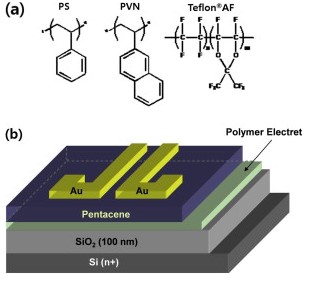Charge transfer and trapping properties in polymer gate dielectrics for non-volatile organicfield-effect transistor memory applications
- 저자
- Kang-Jun Baeg, Yong-Young Noh*, Dong-Yu Kim*
- 저널명
- Solid-State Electronics, 53, 11, 1165-1168 (2009)
- 년도
- 2009
- Link
- https://doi.org/10.1016/j.sse.2009.07.003 420회 연결
[Abstract]
We investigate here charge transfer and trapping characteristics of various chargeable polymer dielectric layers, polystyrene (PS), poly(4-vinyl naphthalene) (PVN), and amorphous fluoropolymer (Teflon® AF) in non-volatile pentacene field-effect transistor (FET) memory devices. Non-volatile memory properties, i.e., the degree of threshold voltage (VTh) shifts (memory window), the programming and erasing bias, and the retention time, strongly depended on the selection of a charge storage layer, due to its electronic and dielectric properties. The pentacene FETs with PVN or PS showed reversible positive and negative VTh shifts by an application of external gate bias. In Teflon® AF device, most significant positive VTh shift was obtained indicating a efficient electron injection whereas showed inefficient erasing characteristics via hole injection and storing due to a high electronegative properties of fluorine units in the dielectric. This result indicates importance of a selection of the chargeable polymer dielectric to obtain efficient organic non-volatile memory with a long retention time.
